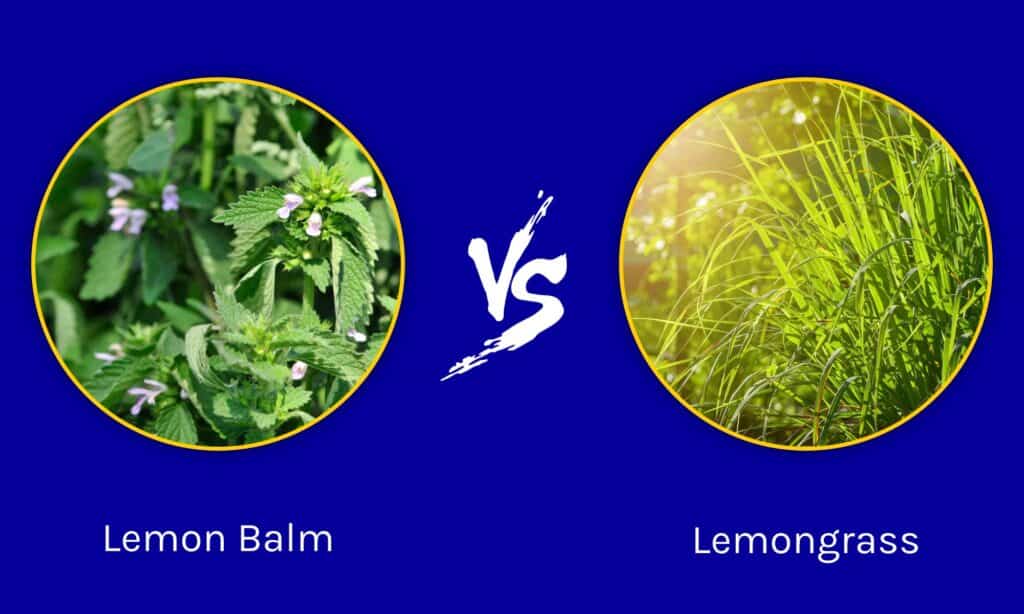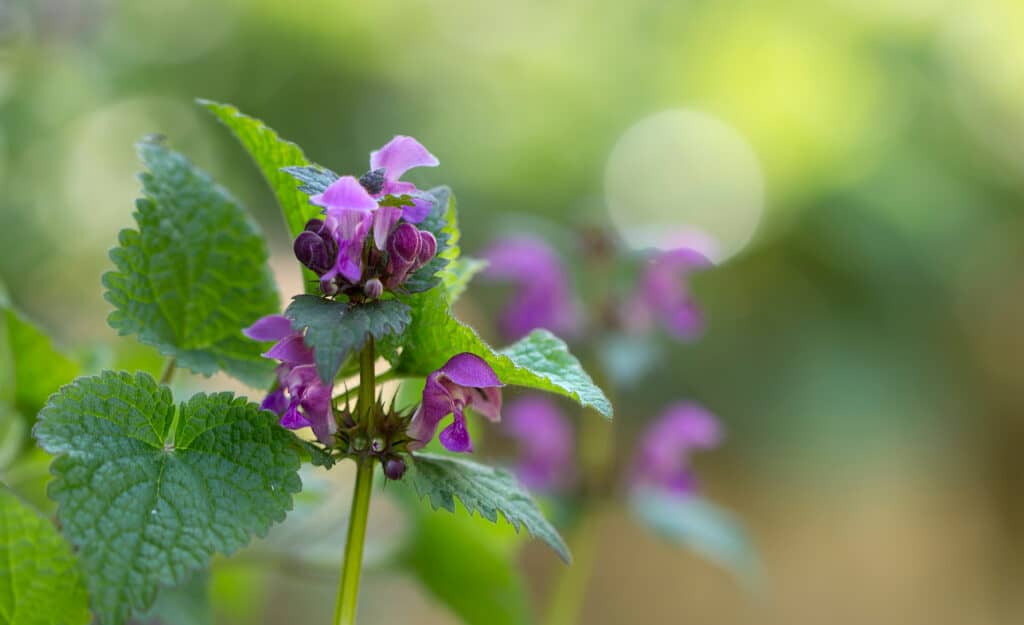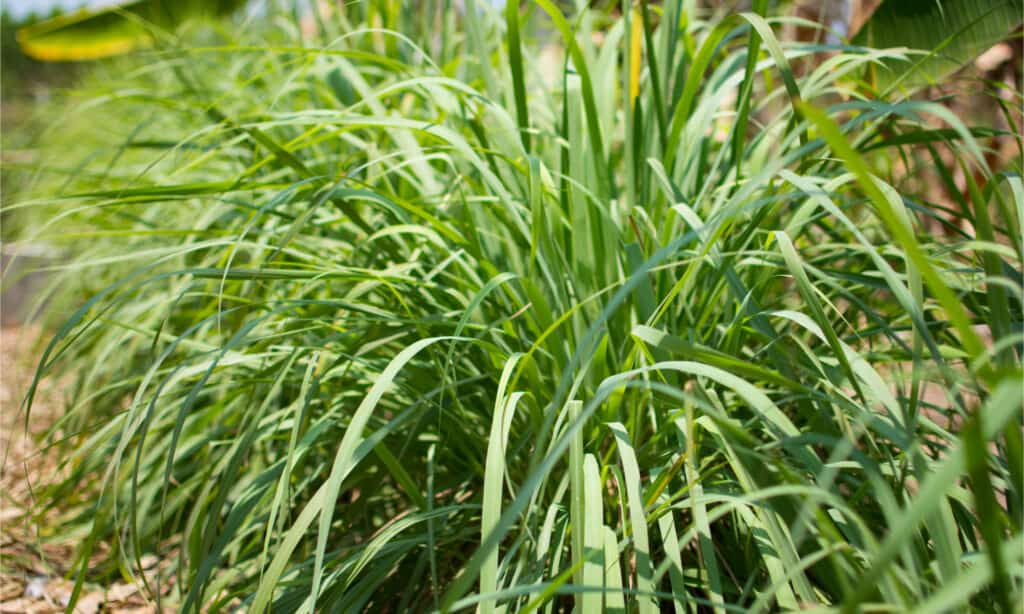There is actually very little in common with lemon balm vs. lemongrass. Both produce a citrussy scent for which they’re named, but there is more that differentiates them than unites them. So what are the differences between lemon balm and lemongrass?
This article pits these two well-loved herbs against each other, comparing and contrasting lemon balm with lemongrass. We’ll cover things like lemon balm vs. lemongrass scientific classifications, their appearances, and what they’re typically used for. There’s even advice on what growing conditions each likes best, so you can try growing your own! Let’s find out more.
Comparing Lemon Balm vs. Lemongrass

| Lemon Balm | Lemongrass | |
|---|---|---|
| Classification | Melissa officinalis, two main subspecies: variegated and golden. From the family Lamiaceae (formerly called Labiatae). | Cymbopogon citratus; sometimes called sera, takrai, and zabalin. From the family Gramineae. |
| Description | Hardy perennial. 30in height, 18in spread. Produces green oval leaves and clusters of pale flowers. | Perennial tall grass with sharp-edged leaves that grow in clumps. Has a whitish, slightly bulbous base, and produces compound flowers on spikes. 6ft height |
| Uses | Culinary, medicinal, good for attracting pollinators. | Widely used in cooking, especially in curries. |
| Origin and Growing Preferences | Originated in Mediterranean and central Europe; very hardy and will tolerate a wide range of conditions. | Tropical plant native to maritime southeast Asia; can only be grown outdoors in tropical climates and is not hardy to frost. |
| Special Features and Fun Facts | In the Middle Ages, ladies made linen or silk amulets filled with lemon balm as a lucky love charm. | Shows promise as a fly repellent and is an ingredient in mosquito repellent. |
Key Differences Between Lemon Balm vs. Lemongrass
The key differences between lemon balm and lemon grass include classification, description, uses, origin, and how to grow.
While you might occasionally mix up the names, you’ll never mistake lemon balm for lemongrass. The two look completely different. Lemon balm usually doesn’t grow any taller than 2.5 feet, while lemongrass can reach far loftier heights, especially when not grown in a container. It also spreads out more than lemon balm, forming large, fountain-shaped clumps. In terms of flowers, lemon balm produces little clusters of pale flowers in the summer; lemongrass only produces big, thorny flowers in tropical weather.
Lemon balm and lemongrass come from very different families. Lemon balm belongs to Lamiaceae or the mint family, and lemongrass comes from the grass family Gramineae. This makes it all the more remarkable that they have such similar scents and uses!
But not too similar; these two plants are not interchangeable in preparing most dishes. They have different cooking times and produce different flavor profiles: lemon balm creates a sweet flavor, while lemongrass is astringent.
Lastly, they have very different growing requirements. Lemon balm is quite hardy and thrives in its native European climes; by contrast, lemongrass cannot tolerate frost and must be grown in a container or greenhouse outside of tropical environments. One thing they do have in common is their numerous medicinal uses. Both are widely used by aromatherapists, traditional medicine practitioners, and as teas.
Lemon Balm vs. Lemongrass: Classification

Lemon balm has been used medicinally for over 2,000 years for everything from headaches and tension to memory restoration.
©Ulrike Adam/Shutterstock.com
While they both have citrus-themed names and are both perennials, the similarities in lemon balm vs. lemongrass end there. The generic name for Lemon balm, Melissa, comes from the Greek word for bee and stems from the belief that if you put sprigs of lemon balm in an empty hive it would attract a swarm. It belongs to the family Lamiaceae, which also includes mint, sage, and lavender. On the other hand, lemongrass hails from the Gramineae family, which includes plants like bamboo, bluegrass, and rice. The hint is in the latter half of its name: it’s a grass! There are over 50 subspecies of lemongrass, including citronella, East Indian lemongrass, and Java citronella.
Lemon Balm vs. Lemongrass: Description
Despite their similar names, lemon balm and lemongrass look completely different. Lemon balm has green, oval-toothed, slightly wrinkled, and highly aromatic leaves. In the summer, it produces clusters of small, pale yellow or white flowers. By contrast, lemongrass is characterized by grassy clumps of thin, razor leaves and can reach heights of up to 6 feet, dwarfing lemon balm! The stems are slightly swollen at the base, and this lower bit is the most prized.
Lemon Balm vs. Lemongrass: Uses
Lemon balm has many uses, including culinary, medicinal, and agricultural. Add fresh lemon balm to vinegar, teas, and beers; it’s also a welcome addition sprinkled on fish or mushroom dishes. Lemon balm has been used medicinally for over 2,000 years for everything from headaches and tension to memory restoration. In aromatherapy, it’s used to counter depression and insomnia, and it can help alleviate flatulence after a meal. It’s also extremely attractive to bees and is a good choice for planting around beehives and orchards. The aroma is rapidly lost, along with much of its therapeutic value, when dried or stored.
Lemongrass is another kitchen staple around the world. It is especially popular in Southeast Asia, where it is known as sera or sereh, and is often paired with chicken and curries. Lemongrass is also frequently brewed into tea. Unlike lemon balm, it can be successfully dried and stored, and is even available in a powdered form. It can be kept in the refrigerator or even the freezer, prolonging its lifespan significantly over lemon balm. It is found throughout traditional and folk medicinal practices in Brazil and India, where it is used as an antifungal, a stimulant, and even as a hypnotic. However, laboratory testing suggests that it does have anti-inflammatory properties, as well as being a possible antioxidant. Additionally, it is a component of citronellol, an important mosquito repellent.
Lemon Balm vs. Lemongrass: Origin and How to Grow

Lemongrass has anti-inflammatory properties, as well as being a possible antioxidant.
©Nannie_iiuu/Shutterstock.com
A native of the Mediterranean region and central Europe, the Lemon balm will grow in almost any soil and in any position. It does prefer a fairly rich, moist soil in a sunny position with some midday shade. Like its cousins, the mint family, in the right conditions, it can turn invasive and problematic, so be sure to keep it in check with regular trimming. Lemon balm’s cultivars ‘All Gold’ and ‘Aurea’ only propagate by cuttings or root division.
Lemongrass, meanwhile, comes from almost the opposite side of the globe! It originates from maritime southeast Asia and thrives in tropical climates. Because of this, outside of tropical conditions, it must be brought indoors after enjoying the summer. It prefers a sheltered position and plenty of water and requires cutting back in autumn. These fountains of foliage can be harvested year-round by cutting the stems at their base. It typically lives to be four years old in the wild.
Fun Facts About Lemon Balm and Lemongrass
Lemon balm is a flavoring for certain cheeses in Switzerland, and its popularity in France for cordials led to its nickname, ‘Tea de France.’ Prince Llewellyn of Glamorgan claimed to drink lemon balm tea every day of his 108 years, leading to it being attributed to promoting long life. Beekeepers sometimes use lemongrass oil to attract swarms and may also repel pests like the stable fly.
Up Next:
- German Thyme vs. English Thyme: What Are The Differences?
- American Ginseng vs Korean Ginseng: 5 Key Differences
- French Lavender vs English Lavender: Is There a Difference?
The photo featured at the top of this post is © iStock.com/ARISA THEPBANCHORNCHAI
Sources
- National Library of Medicine, Available here: https://pubmed.ncbi.nlm.nih.gov/20438326/
- eMediHealth, Available here: https://www.emedihealth.com/nutrition/lemongrass
- The Royal Horticultural Society, Available here: https://www.rhs.org.uk/herbs/lemon-balm/grow-your-own
Thank you for reading! Have some feedback for us? Contact the AZ Animals editorial team.






